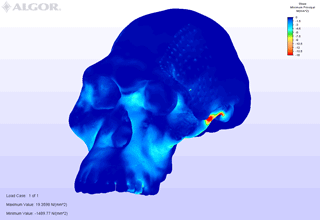Early Humans were Nuts About Seeds
Biomechanical study by UAlbany-led research team finds that ancient humans likely ingested large, hard nuts and seeds as part of a survival strategy
Contact(s): Catherine Herman (518) 956-8150
 |
Figure legend: Compressive stress in the cranium of Australopithecus africanus, an extinct early human, imposed by biting on the premolar teeth. Bright colors correspond to high stresses, and indicate that a bony pillar running alongside the opening of the nasal cavity acts as a strut that structurally reinforces the face against premolar loads. |
ALBANY, N.Y. (February 2, 2009) -- New research published in the Proceedings of the National Academy of Sciences has led to novel insights into how feeding and dietary adaptations may have shaped the evolution of the earliest humans.
An international research team led by University at Albany anthropologist David Strait found that a two million year-old early human relative likely ingested large nuts and seeds that may have been "foods of last resort." The article "The feeding biomechanics and dietary ecology of Australopithecus africanus," appears in the February 2009 issue of Proceedings.
The team tested long-standing, influential hypotheses suggesting that the unusual facial skeletons of certain early humans contained anatomical features that structurally buttressed the face against forces applied to the premolar teeth (also known as bicuspids) when either biting on small, hard objects or when processing large volumes of food using many teeth at once.
The team found that Australopithecus africanus, a human relative that lived in Africa over two million years ago, had a facial skeleton that was well designed to withstand premolar bites, but that a small object or high volume diet was unlikely to explain the evolution of facial anatomy in this species. Instead, the team suggests that A. africanus might have used their enlarged premolars and structurally reinforced face to crack open and ingest large hard nuts and seeds that may have been critical resources upon which these humans relied during times of resource scarcity or when their preferred foods were unavailable.
"Because Australopithecus lived during a period in which climates were changing and unstable, the ability to eat foods that were difficult to process may have been an ecologically significant adaptation," said Strait, an associate professor at UAlbany and co-director of the human biology program. "Suppose that you�re an animal that eats soft fruits. When those fruits disappear, you only have a few choices: move to a different habitat, die, or eat something else. Nut cracking gave these early humans the ability to shift their diet when times got tough."
To conduct their research, the team utilized advanced experimental, comparative and imaging techniques along with finite element analysis, an engineering method used to examine how objects of complex geometry respond to loads.
The research was made possible through grants from the National Science Foundation and the European Union.
At UAlbany, Strait's work continues a streak of research success by scientists in the Department of Anthropology. During the last year, two other University researchers have published their findings in Proceedings, one of the world's top science journals. In February of 2008, Sharon DeWitte reported that, contrary to prior thought, the Black Death did not kill indiscriminately but instead preyed upon the weaker members of society. In March of last year, Adam Gordon analyzed skull shape in the "hobbit," a small-bodied fossil human with a chimpanzee-sized brain that lived in Indonesia 17,000 years ago, and found that it was most similar in shape to Homo habilis, an extinct human species that lived in Africa 1.8 million years ago. This suggested to him that a separate lineage of human relatives shared the planet with our own ancestors for almost two million years. Gordon�s research was named one of the top 100 science stories of 2008 by Discover magazine.
"It's exciting," says Strait about the studies published in PNAS. "Three in one year is a good record by any standard."
![]() For more news, subscribe to UAlbany's RSS headline feeds
For more news, subscribe to UAlbany's RSS headline feeds
Educationally and culturally, the University at Albany-SUNY puts "The World Within Reach" for its 18,000 students. An internationally recognized research university with 58 undergraduate majors and 128 graduate degree programs, UAlbany is a leader among all New York State colleges and universities in such diverse fields as public policy, nanotechnology and criminal justice. With a curriculum enhanced by 300 study-abroad opportunities, UAlbany launches great careers. For more information about this globally ranked University, visit www.albany.edu. For UAlbany's extensive roster of faculty experts, visit www.albany.edu/news/experts.shtml.


